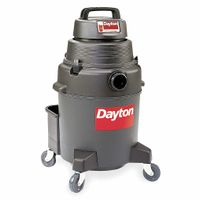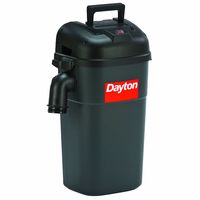Call +(254) 703 030 000 / 751 483 999 / 721 704 777
- Home
- Cleaning And Janitorial
- Floor Cleaning Machines
- Vacuum Cleaners Accessories
- Shop Wet Dry Vacuum Cleaners
.....Read More
Frequently Asked Questions
What is the best shop vacuum for wet and dry use?
The best shop vacuum for wet and dry use is the Craftsman CMXEVBE17595. This vacuum is highly regarded for its powerful 6.5 peak horsepower motor, which provides strong suction for both wet and dry debris. It features a large 16-gallon tank, allowing for extended cleaning sessions without frequent emptying. The Craftsman CMXEVBE17595 is equipped with a dual-flex hose that offers 180-degree mobility at each end, reducing the risk of kinks and improving maneuverability.
Additionally, this vacuum includes a variety of attachments, such as a utility nozzle, car nozzle, wet nozzle, and two extension wands, making it versatile for different cleaning tasks. The built-in blower port allows it to function as a blower, adding to its versatility. Its Qwik Lock Filter Fastening System makes filter changes quick and easy, and the oversized drain port facilitates fast liquid disposal.
The Craftsman CMXEVBE17595 is also designed with convenience in mind, featuring a large on/off switch with a water-resistant design, a built-in cord wrap, and accessory storage to keep everything organized. Its durable construction ensures longevity, making it a reliable choice for both professional and home use. Overall, the Craftsman CMXEVBE17595 offers a combination of power, capacity, and versatility, making it the best choice for those seeking a high-performance wet and dry shop vacuum.
How do you clean a shop vacuum filter?
1. **Turn Off and Unplug**: Ensure the vacuum is turned off and unplugged from the power source to prevent any accidents.
2. **Remove the Filter**: Open the vacuum according to the manufacturer's instructions and carefully remove the filter. Note the filter's position for correct reinstallation.
3. **Shake Off Loose Debris**: Take the filter outside or to a trash bin. Gently tap it against a hard surface to dislodge loose dirt and debris.
4. **Brush Off Dust**: Use a soft brush or a toothbrush to remove any remaining dust and debris from the filter's surface. Be gentle to avoid damaging the filter material.
5. **Rinse with Water**: If the filter is washable, rinse it under lukewarm running water. Avoid using high pressure, which can damage the filter. Rinse until the water runs clear.
6. **Use Mild Detergent**: For stubborn dirt, use a mild detergent. Gently scrub the filter with a soft brush, then rinse thoroughly to remove all soap residue.
7. **Dry Completely**: Allow the filter to air dry completely before reinstalling. Place it in a well-ventilated area, away from direct sunlight or heat sources, to prevent warping or damage.
8. **Reinstall the Filter**: Once dry, reinstall the filter in the vacuum, ensuring it is securely in place as per the manufacturer's instructions.
9. **Regular Maintenance**: Clean the filter regularly to maintain optimal vacuum performance. Replace the filter if it shows signs of wear or damage.
10. **Check Manufacturer's Guidelines**: Always refer to the vacuum's manual for specific cleaning instructions and recommendations for your model.
Can a shop vacuum pick up water?
Yes, a shop vacuum, also known as a wet/dry vacuum, can pick up water. These vacuums are specifically designed to handle both dry debris and liquid spills, making them versatile tools for various cleaning tasks. They are equipped with a powerful motor and a robust filtration system that allows them to safely and efficiently suck up water without damaging the machine.
When using a shop vacuum to pick up water, it's important to follow certain steps to ensure safety and effectiveness:
1. **Remove the Dust Bag and Filter**: Before vacuuming water, remove any dust bags and dry filters to prevent damage. Some models come with a foam sleeve or a specific wet filter that should be used when picking up liquids.
2. **Check the Capacity**: Be aware of the vacuum's tank capacity to avoid overfilling. Most shop vacuums have a float mechanism that stops suction when the tank is full, but it's good practice to monitor the water level.
3. **Use the Appropriate Attachment**: Many shop vacuums come with specific attachments for wet vacuuming, such as a squeegee or a wide nozzle, which help in efficiently picking up water.
4. **Empty the Tank Regularly**: After vacuuming, promptly empty the tank to prevent mold growth and odors. Clean and dry the tank thoroughly before storing the vacuum.
5. **Safety Precautions**: Ensure that the vacuum is plugged into a GFCI outlet to prevent electrical hazards. Avoid using the vacuum in areas with standing water where the electrical cord or motor could be submerged.
By following these guidelines, a shop vacuum can be a highly effective tool for cleaning up water spills, floods, or leaks in various settings.
What size shop vacuum do I need for my workshop?
To determine the appropriate size shop vacuum for your workshop, consider the following factors:
1. **Workshop Size and Debris Type**:
- For small workshops or light debris (sawdust, small wood chips), a vacuum with a capacity of 2 to 6 gallons is sufficient.
- Medium-sized workshops or moderate debris (larger wood chips, small metal shavings) may require a 6 to 12-gallon vacuum.
- Large workshops or heavy debris (large wood pieces, metal scraps) need a vacuum with a capacity of 12 to 20 gallons or more.
2. **Power and Performance**:
- Look for a vacuum with a motor power of at least 3 to 5 horsepower for general use.
- Higher horsepower (6 HP or more) is better for heavy-duty cleaning and larger debris.
3. **Portability and Storage**:
- Smaller vacuums are more portable and easier to store, ideal for limited space.
- Larger vacuums may have wheels and handles for easier movement but require more storage space.
4. **Filtration System**:
- Ensure the vacuum has a good filtration system, especially if you deal with fine dust or allergens.
- HEPA filters are recommended for capturing fine particles.
5. **Additional Features**:
- Consider features like wet/dry capability, blower function, and accessory storage.
- Check for attachments like crevice tools, extension wands, and floor nozzles for versatility.
6. **Budget**:
- Prices vary based on size and features. Set a budget that balances your needs with affordability.
By evaluating these factors, you can select a shop vacuum that efficiently meets the cleaning demands of your workshop.
How do you maintain a shop vacuum?
To maintain a shop vacuum, follow these steps:
1. **Regular Cleaning**: After each use, empty the vacuum's collection tank. For bagged models, replace the bag when it's two-thirds full. For bagless models, empty the canister and wash it with warm, soapy water.
2. **Filter Maintenance**: Check the filters regularly. Clean reusable filters with water and let them dry completely before reinserting. Replace disposable filters as per the manufacturer's recommendations or when visibly dirty.
3. **Hose and Attachments**: Inspect the hose and attachments for blockages or damage. Remove any debris and ensure there are no cracks or holes that could affect suction.
4. **Motor Care**: Keep the motor area clean and free of dust. Use a dry cloth or compressed air to remove dust from vents and motor housing.
5. **Check for Leaks**: Ensure all seals and gaskets are intact to prevent air leaks. Replace any worn or damaged seals.
6. **Inspect Power Cord**: Regularly check the power cord for frays or damage. Replace the cord if necessary to prevent electrical hazards.
7. **Lubrication**: If the vacuum has moving parts that require lubrication, apply a suitable lubricant as per the manufacturer's instructions.
8. **Storage**: Store the vacuum in a dry, cool place. Ensure the cord is neatly wrapped and the vacuum is not exposed to extreme temperatures or moisture.
9. **Routine Inspection**: Periodically inspect the vacuum for any unusual noises or performance issues. Address any problems promptly to prevent further damage.
10. **Follow Manufacturer's Guidelines**: Always refer to the user manual for specific maintenance instructions and adhere to the recommended service intervals.
Are shop vacuums suitable for home use?
Yes, shop vacuums are suitable for home use. They are versatile and powerful, making them ideal for a variety of cleaning tasks beyond what a regular household vacuum can handle. Shop vacuums, also known as wet/dry vacuums, are designed to clean up both liquid spills and dry debris, which is particularly useful in homes with workshops, garages, or basements. Their robust suction power can efficiently handle larger debris, such as sawdust, nails, or small wood chips, which might clog a standard vacuum.
Additionally, shop vacuums often come with a range of attachments and accessories that enhance their functionality, allowing them to clean hard-to-reach areas, upholstery, and even car interiors. They are also generally more durable and have larger capacity tanks, reducing the frequency of emptying the vacuum.
However, there are some considerations to keep in mind. Shop vacuums tend to be bulkier and noisier than regular vacuums, which might be a drawback for some users. They may also lack the advanced filtration systems found in high-end household vacuums, which can be a concern for those with allergies. Furthermore, their design is often more utilitarian, which might not blend well with home decor if storage space is limited.
In summary, while shop vacuums are highly effective for heavy-duty cleaning tasks and can be a valuable addition to home cleaning tools, they may not completely replace a traditional vacuum for everyday cleaning due to their size, noise level, and lack of advanced filtration.
How do you unclog a shop vacuum hose?
1. **Turn Off and Unplug**: Ensure the vacuum is turned off and unplugged to prevent any accidents.
2. **Detach the Hose**: Remove the hose from the vacuum unit. This usually involves unscrewing or unclipping it from the main body.
3. **Inspect the Hose**: Look through the hose to identify the location of the clog. If the clog is visible, you can try to remove it manually.
4. **Use a Long Object**: Insert a long, flexible object like a broom handle or plumbing snake into the hose to push out the clog. Be gentle to avoid damaging the hose.
5. **Reverse the Hose**: Attach the hose to the exhaust port of the vacuum. Turn on the vacuum to blow the clog out from the opposite end.
6. **Flush with Water**: If the clog persists, take the hose outside and run water through it using a garden hose. This can help dislodge stubborn debris.
7. **Use Compressed Air**: If available, use a can of compressed air or an air compressor to blow out the clog.
8. **Reattach and Test**: Once the clog is cleared, reattach the hose to the vacuum and test it to ensure proper suction.
9. **Prevent Future Clogs**: Regularly check and clean the hose, and avoid vacuuming large debris that can cause blockages.



